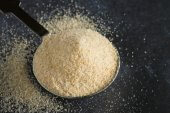


Shallot powder, derived from the delicate and slightly sweet shallot, offers a milder onion flavor that subtly enhances salad dressings, vinaigrettes, delicate fish and vegetable dishes, sauces, dips, egg dishes, and lighter soups and stews.
10-12 shallots
In the Dehydrator
In the Oven
Find it online: https://foodgardening.mequoda.com/recipe/shallot-powder/